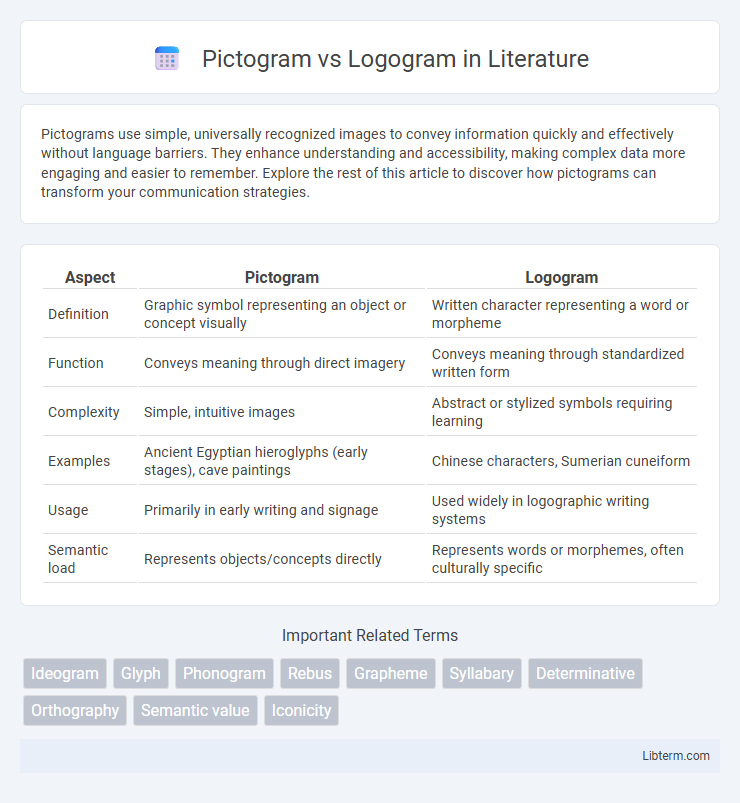Pictograms use simple, universally recognized images to convey information quickly and effectively without language barriers. They enhance understanding and accessibility, making complex data more engaging and easier to remember. Explore the rest of this article to discover how pictograms can transform your communication strategies.
Table of Comparison
| Aspect | Pictogram | Logogram |
|---|---|---|
| Definition | Graphic symbol representing an object or concept visually | Written character representing a word or morpheme |
| Function | Conveys meaning through direct imagery | Conveys meaning through standardized written form |
| Complexity | Simple, intuitive images | Abstract or stylized symbols requiring learning |
| Examples | Ancient Egyptian hieroglyphs (early stages), cave paintings | Chinese characters, Sumerian cuneiform |
| Usage | Primarily in early writing and signage | Used widely in logographic writing systems |
| Semantic load | Represents objects/concepts directly | Represents words or morphemes, often culturally specific |
Introduction to Pictograms and Logograms
Pictograms are visual symbols that represent objects or concepts directly through simplified images, often used in early written communication systems like ancient Egyptian hieroglyphs and early Chinese script. Logograms, on the other hand, are written characters that represent words or morphemes rather than just individual objects, prominent in languages such as Chinese, where each character corresponds to a meaningful unit of language. Understanding the distinction between pictograms and logograms is essential for studying the evolution of writing systems and how human communication transitioned from purely visual representations to complex linguistic symbols.
Defining Pictograms: Characteristics and Examples
Pictograms are visual symbols that represent objects or concepts through simple, universally recognizable images, characterized by their direct depiction of physical entities without abstract elements. Common examples include restroom signs, road symbols, and weather icons, which rely on intuitive imagery to convey clear, immediate meaning. These symbols serve as foundational communication tools in diverse contexts due to their straightforward, language-independent design.
Understanding Logograms: Core Features and Instances
Logograms are written characters that represent entire words or morphemes, with Chinese characters and Egyptian hieroglyphs serving as primary examples. They differ from pictograms, which depict objects visually, as logograms encode meaning directly without illustrating the object's appearance. This method allows for efficient communication of complex concepts through standardized symbols that can convey abstract ideas beyond simple imagery.
Historical Evolution: Pictograms to Logograms
Pictograms originated as simple visual symbols representing objects or concepts in ancient cultures, serving as the foundation for early written communication. Over time, these images evolved into logograms, which encoded complex words or morphemes, enabling more nuanced expression and record-keeping. This transition marked a significant advancement in writing systems, as logograms facilitated the development of scripts like Egyptian hieroglyphs and Chinese characters, bridging pictorial representation with linguistic meaning.
Visual Differences between Pictograms and Logograms
Pictograms are simple, visually representative symbols that directly depict objects or concepts, making them easily recognizable through their illustrative form. Logograms, however, represent entire words or morphemes and often abstract their images to convey meaning beyond the literal depiction, resulting in more stylized or symbolic designs. The key visual difference lies in pictograms' straightforward, image-like appearance versus logograms' abstract, culturally defined symbols used in writing systems like Chinese characters or Egyptian hieroglyphs.
Functionality and Use in Modern Communication
Pictograms convey meaning through simple, universally recognizable images, making them highly effective for quick comprehension in public signage and digital interfaces. Logograms represent words or morphemes symbolically, enabling efficient written communication in languages such as Chinese, where characters encapsulate complex concepts. Modern communication leverages pictograms for intuitive visual cues, while logograms support detailed linguistic expression and information density in written form.
Cultural Significance of Pictograms and Logograms
Pictograms and logograms both serve as visual representations in written communication, but pictograms convey meaning through direct imagery, while logograms represent words or morphemes symbolically. Pictograms hold deep cultural significance as they often derive from universally recognizable images, reflecting shared human experiences and traditional narratives within societies. Logograms carry profound cultural weight by encapsulating complex linguistic and historical elements, preserving the evolution of language and identity across generations in civilizations such as ancient China and Mesopotamia.
Advantages and Limitations of Pictograms
Pictograms offer clear visual representation, making them easily understandable across different languages and cultures, which enhances quick communication and learning. Their simplicity enables efficient information transfer in public signage, but they lack the precision required for complex or abstract concepts. Limitations arise when pictograms become ambiguous or culturally specific, potentially causing misinterpretation without standardized context or supplementary text.
Pros and Cons of Logograms
Logograms offer the advantage of representing whole words or morphemes, enabling efficient communication and reducing the number of characters needed to convey complex ideas. However, their complexity often requires extensive memorization, making them less accessible for learners compared to phonetic systems. The reliance on logograms can also hinder literacy development due to the vast number of unique symbols required for fluency.
Conclusion: Comparing Pictograms and Logograms
Pictograms represent objects or concepts through simple images closely resembling their meaning, making them intuitive and easy to understand across cultures. Logograms, however, symbolize words or morphemes, offering greater linguistic complexity and efficiency in written language, as seen in Chinese characters or ancient Egyptian hieroglyphs. The choice between pictograms and logograms depends on communication needs; pictograms excel in universal signage, while logograms facilitate detailed expression in developed writing systems.
Pictogram Infographic

 libterm.com
libterm.com